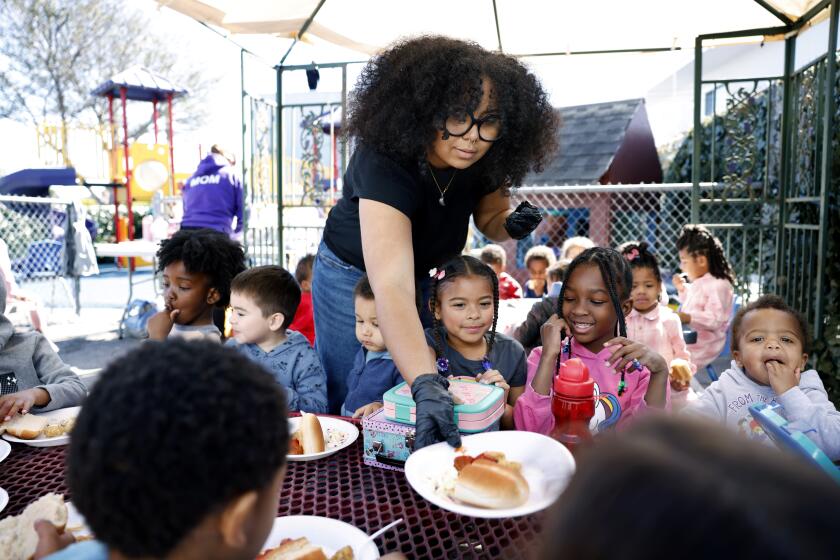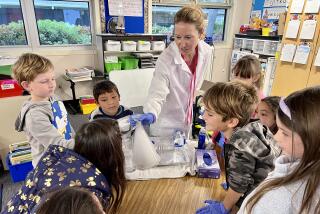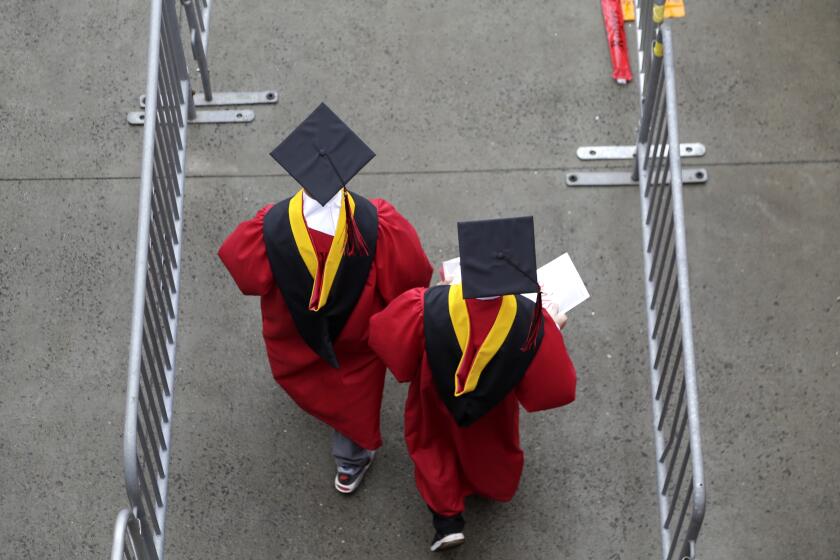Bugs and ‘bubble breaths’: How new teacher training peers into the mind of a 4-year-old

Consider the humble lump of pink Play-Doh.
To a parent, it’s a quick toddler playtime activity. But ask an early childhood educator about Play-Doh, and it’s a science experiment, an opportunity for sensory exploration, a fine motor skills activity, and an introduction to color mixing, all rolled into one squishy blob.
“We could do so much with two jars of Play-Doh and an hour,” said Kaitlin Fullerton, who has been a preschool teacher and director for 14 years. “An educator of older children would look at that very differently.”
When California launched its historic expansion of public education in 2020 with the addition of a new grade level — TK, short for transitional kindergarten — a key component was missing: teacher training to understand how the 4-year-old brain learns. The existing credential programs prepared teachers for math and literacy instruction in the wide expanse of kindergarten through 8th grade and all but excluded the state’s newest and youngest students.
“Four- to 5-year-olds are very different from 12- to 13-year-olds,” said Deborah Stipek, an education professor at Stanford University. “The development of TK brought home that we weren’t really preparing teachers to teach little kids,” though much is at stake when it comes to a child’s earliest years in school.
Engage with our community-funded journalism as we delve into child care, transitional kindergarten, health and other issues affecting children from birth through age 5.
Beginning next year, the state will require elementary school teachers in TK classrooms to have the equivalent of 24 units of early childhood education or development credits, about eight classes. And in a major effort aimed at improving the consistency of early childhood education, the state is also introducing a new credential for teachers who want to specialize in transitional kindergarten through third grade.
For parents who are considering TK, the enhanced training means their child’s first experiences in public school will probably be steeped in joyful, play-based lessons designed to help the state’s youngest learners develop social skills and a love of learning, and lay the early foundations for literacy and math in environments that look little like a traditional classroom.
For veteran child-care providers, who are among the lowest-paid workers in the economy, the new credential stands to increase their earning potential as full-fledged teachers. In California, 98% of child-care workers are women, and more than half are people of color.
“I get at least 10 emails a day from people in the community asking when is this coming?” said Valerie Helgren-Lempesis, a CSU East Bay education professor who is setting up the school’s new program. “This credential is going to equalize the field for women of color and immigrant women who have a [bachelor’s] degree and are already working in early childhood.”

For Fullerton the credential will also recognize her deep understanding of young children — and the magical learning potential of Play-Doh.
“I think sometimes in child care, the teachers get overlooked,” she said. “By bringing [preschool] in and making it a part of the school system, it brings a new level of respect.”
L.A.’s child-care industry sees big disruptions and uncertainties brought on by a dramatically shifting landscape. Enrollment is still down with no signs of a rebound.
What do 4-year-olds need to know?
In 2016, when the state’s TK program was last evaluated, researchers found that teachers spent 59% of their classroom time on “didactic instruction,” which means imparting information and instructions to students rather than encouraging independent thinking and play.
Not the best way to teach squirmy 4-year-olds, experts said.
This academic focus in TK and kindergarten, Stipek said, is partly a consequence of the way teachers are being educated. “They’re prepared to teach disciplines like math and literacy. But 4-year-olds learn through play and developing social-emotional skills.”
Deciding between preschool and transitional kindergarten isn’t easy for parents. Here’s how eligibility, structure and academic environment may differ.
Instead of being taught their letters and numbers from a teacher standing at the front of the class, young children in a well-run classroom should be playing games and exploring materials to learn in joyful and imaginative ways, according to a recent report on preschool curriculum by the National Academies of Sciences, Engineering and Medicine.
But this takes careful planning and know-how, Stipek said.
Take a math lesson on simple addition for the 4-year-old brain.
Transitional kindergarten is now serving nearly all 4-year-olds, but teachers haven’t been trained to understand how such young brains learn.
“You might have a small group of kids with a bunch of little colored bears. Then you tell a story and say, ‘OK, you have eight bears, and the bears are going for a walk in the forest and two more join them. How many bears do you have?’” Stipek said. “Now that’s a little different from doing a worksheet.”
Ideally, a math lesson would also be integrated into a larger classroom theme, said San Jose State child and adolescent development professor Maria Fusaro. A teacher might pick a theme such as trees. Students might then learn the names of various trees from picture books (literacy), observe them in nature (science), count and compare different leaves (math, science) and then draw pictures of them (art).
“We want schools to be joyful places for children,” she said. And not just in TK — Fusaro said she hopes the new credential will help push play-based learning up to third grade as well.
Up close with California’s future teachers
In September, a group of 20 eager students sat down for a class on child development at San Jose State University, the first college to launch a credential for preschool through third grade. Most are women of color, and almost all have had previous experience teaching at preschool or child-care centers.
For those who already have a bachelor’s degree, earning this credential is the key to doubling their earnings in public schools.
Black and Latina child-care workers are paid less and given fewer leadership roles than their co-workers, despite making up much of the early childhood workforce.
Professor Danielle Mead sat at the front of the room, wearing a collared dress patterned with little strawberries. Behind her, a slide read “Social and Emotional Development” — a major focus of this credential, and of most preschool programs.
Young children have not yet learned to control their reaction when something happens, she explained. When another child takes a toy out of their hands, for instance, it can trigger a meltdown.
“A lot of times when kids start to have those big feelings, it’s really hard to make the effort to stop. It requires a lot of practice and a lot of support,” she said. The class focuses on mindfulness practices geared to little ones, which a growing body of research suggests can improve young children’s learning, in addition to their social and emotional skills.
Take deep breathing. How do you explain this technique to a child?
“Call it bubble breathing,” Mead said, putting on a podcast in which Sesame Street muppet Abby Cadabby teaches children how to use bubble breaths to calm themselves. “All you have to do is imagine there’s a giant bubble in your belly,” the character said. “Put your hands on your belly like you’re holding the bubble.”
The students take turns describing the mindfulness activities they’ve used with children in the past — smelling flowers, morning yoga sessions for tots.
The program at San Jose State is a collaboration among the departments of child and adolescent development, teacher education, and special education. The new credential is supposed to focus on holistic development — in which children learn how to manage their emotions, build healthy relationships and show empathy, in addition to learning academics — setting it apart from previous credentialing programs.
“I can teach anybody the ABCs. But, you know, we’ve all met plenty of adults who don’t know how to share,” Fullerton said.
“A great concern in the early childhood community was that TK would bring a more academic focus to preschool than is appropriate for these learners,” said Mary Vixie Sandy, executive director of California’s Commission on Teacher Credentialing. “This credential enables us to blend developmental and play-based learning with the academic expectations of schooling in ways that benefit children and don’t force them into learning experiences that are not appropriate for them.”
Sandy said she hopes the new credential will one day be offered at all 80 institutions in California that currently offer teacher credential programs.
New respect for preschool teachers
An estimated 12,000 to 15,000 additional teachers are needed to staff TK classrooms, the Learning Policy Institute said in 2022, though many of those slots are likely to have been filled already. The new credential represents an opportunity to bolster that pipeline with longtime preschool teachers like Fullerton, as well as college students who know they want to teach young children.
Resources for prospective teachers
- The Commission has career counselors available for one-on-one conversations to provide guidance for prospective or current teachers. Requests can be made via this form
- Information on a wide variety of financial resources available to teacher candidates in California can be found here.
- A Roadmap to Teaching can be found here.
Fullerton’s ‘aha!’ moment came last year, when her twin 4-year-olds watched Disney’s “A Bug’s Life” in their TK class, and the school administration described it as “a science lesson.”
“If I were teaching about bugs, I would have brought in plastic bugs for the children to explore, or taken magnifying glasses outside,” she said.
The class was taught by a former first-grade teacher with a traditional kindergarten through 8th grade credential.
“I’ve been doing it for so long, and I was feeling frustrated as a parent not seeing what I wanted for my kids,” said Fullerton, who is enrolled in the San Jose State program.
Teaching TK would be life-changing financially for her, she said. Even with more than a decade in the field, Fullerton was earning $30 an hour as the director of a preschool in Morgan Hill — just $10 more than when she started as a teacher. But with a credential, she could earn $68,000 to $100,000 a year plus generous benefits.
But it’s also about respect, said Fullerton, who still looked shocked as she recalled how her son’s elementary school teacher once referred to her as a “glorified babysitter.”
That was the moment where it was like, ‘Oh, this work is not respected by a lot of people,’” she said. But, she said, “I think most parents look up to their children’s elementary school teachers. You’re trusting them, literally, to teach your child the foundational skills.”
High stakes for early education
Most states already have an early childhood credential, and the idea had been under discussion in California for years before it was included as a recommendation in Gov. Gavin Newsom’s 2020 Master Plan for Early Learning and Care.

“I’ve been a higher education teacher-educator for close to 30 years in California, and we’ve been waiting for this credential for that long,” said Shireen Pavri, assistant vice chancellor of educator and leadership programs at the CSU chancellor’s office. It’s the first time the state has added a new credential since 2010.
The stakes couldn’t be higher. Third grade is a crucial year for reading and literacy, yet in 2023, just 43% of California’s third-graders met or exceeded the standards in English language and arts; 45% met or exceeded the standard in math. The numbers are even grimmer for low-income students and students of color: Only 23% of low-income children, 27% of Black children and 32% of Hispanic children were reading at grade level.
The first few years of elementary school, Pavri said, present a real opportunity to equalize learning for young children. “Some kids are able to read and write full sentences when they start kindergarten, and then there are kids who have never been exposed to a picture book,” she said.
Help young kids learn to read with expert advice. Find literacy tips and tricks along with book recommendations for parents and educators in the reading guide.
But only if the teaching strategies are effective. Young children should be “getting their hands dirty and using art and play and sand and other kinds of engaging, active ways to stimulate young kids to learn,” Pavri said. “We will have failed if we still see our youngest learners sitting at their desks, on their own in rows and completing worksheets.”
So far, the state has approved seven PK-3 credentialing programs, including San Jose’s and another at Fresno State and Dominguez Hillsthat will launch in the spring. Pavri said 14 more CSU campuses are in the process of developing PK-3 credentialing programs.
This article is part of The Times’ early childhood education initiative, focusing on the learning and development of California children from birth to age 5. For more information about the initiative and its philanthropic funders, go to latimes.com/earlyed.
More to Read
Sign up for Essential California
The most important California stories and recommendations in your inbox every morning.
You may occasionally receive promotional content from the Los Angeles Times.

















